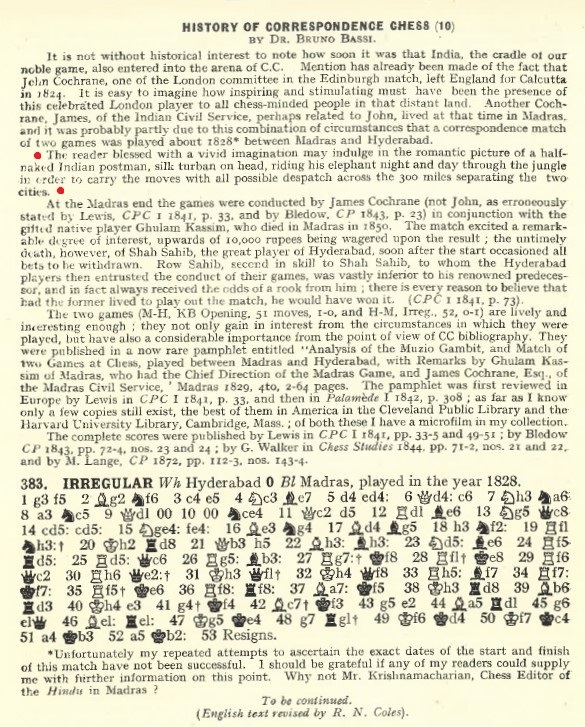
Edward Winter
This draft feature article was launched on 8 September 2014, in C.N. 8819. Information will be added gradually, beginning with citations which have already appeared in C.N. (See, for instance, the references to the Nimzo-Indian Defence in the Factfinder.) Readers’ proposals (full bibliographical references) will be appreciated.
First occurrence of the term ‘Indian’ in labelling any opening:
First occurrence of an equivalent term in any language in labelling any opening:
‘Indian Defence.’ Chess Openings by J. Mason (London, 1897), page 92. A reference to 1 e4 d6.
‘Indian Opening.’ International Chess Magazine, August 1891, page 237. (Heading to a game which began 1 e4 e5 2 d3.)
‘Indian Defence.’ Chess Player’s Chronicle, 22 October 1884, page 172. Note after 1 e4 d6 2 d4 g6: ‘An example of the rare Indian Defence, so called on account of its introduction by the celebrated Indian Chess Player, the Brahmin Moheschunder Bonnerjee, in his games against Cochrane.’
‘The Indian Opening’ (heading to a game between Green and Paulsen beginning 1 e4 e5 2 d3). The note after 2 d3 reads: ‘Our efforts to trace this move to its inventor, by examining the various works treating upon the principles of the openings, have been fruitless. We find no mention made of it by either ancient or modern writers. Mr Green, however, informs us that this opening is common among the native players in Hindostan. We propose, therefore, to name it “the Indian Opening”.’ The Chess Congress of 1862 by J. Löwenthal (London, 1864).
Martin Sims (Upper Hutt, New Zealand) points out a remark in Ghulam Kassim’s annotations to the second game in the Madras-Hyderabad correspondence match, after 1 g3:
‘Many of the Indian Players commence their Game in this way.’
Source: page 45 of Analysis of the Muzio Gambit, and Match of Two Games at Chess, Played Between Madras and Hyderabad by Ghulam Kassim and James Cochrane (Madras, 1829). The book can be read on-line.
Our correspondent asks for information about a sourceless assertion by Andrew Soltis that elephants conveyed the chess moves. On page 10 of Chess Life, January 1990 Soltis wrote:
‘Take the case of the two-game match played more than 160 years ago between the masters of the Bay of Bengal port of Madras and the best players of Hyderabad, some 300 miles up into the interior of India. The surest way of sending the moves back and forth was via the regular mail pouches – that is, the ones carried by elephants.’
And:
‘The 2-0 victory by Madras is almost forgotten by history but should be remembered as The Elephant Match.’
A recent account of the contest is on pages 166-172 of volume one of L’histoire du jeu d’échecs par correspondance au XIXe siècle by Eric Ruch (Aachen, 2010). From pages 166-167:
‘Le lecteur imaginatif peut se représenter l’image romantique d’un postier indien à demi-nu, enturbanné, juché nuit et jour sur un éléphant, pour couvrir à travers l’épaisse jungle, les 300 miles de distance séparant les deux cités, pour y acheminer les coups d’échecs de nos joueurs par correspondance.’
The text, which was not in quotation marks, had a footnote mentioning an article by Bruno Bassi on page 327 of Mail Chess, March 1949. Courtesy of the Royal Library in The Hague, it is shown here:

The article was included in the collection of Bassi’s writings, The History of Correspondence Chess up to 1839 compiled by Egbert Meissenburg (Winsen/Luhe, 1965). An Italian translation, by Enzo Minerva, was published as a supplement to the 5/1991 issue of Telescacco nuovo, Rome under the title Storia del gioco per corrispondenza fino al 1839.
The correspondence match of the late 1820s was discussed on pages 31-33 of Indian Chess History 570 AD-2010 AD by Manuel Aaron and Vijay D. Pandit (Chennai, 2014). Page 31 stated:
‘An unlikely story is that the moves were despatched by golden caparisoned elephants carrying a private postman wearing a crimson turban and pearl-grey livery holding a blue lantern.’
From page 18 of Western Chess In British India (1825-1947) by Vijay D. Pandit (Nottingham, 2011):
‘We know that the moves were transported by liveried servants riding on the back of elephants ...’
The statement is unsubstantiated. We prefer to be told how we know what we are told that we know.
Have writers’ references to transportation by elephant merely misused Bruno Bassi’s light-hearted fancy beginning ‘The reader blessed with a vivid imagination may indulge in the romantic picture of ...’, or is there documentary evidence?
(9982)
First occurrence of the moves 1 d4 e6 2 c4 Bb4+ 3 Nc3 Bxc3+ (Löwenthal v Buckle, fourth match-game, London, 1851; see C.N. 2029 on page 152 of Kings, Commoners and Knaves).
First occurrence of the term ‘Bogoljubow Defence’:
First occurrence of an equivalent term in any language:
First occurrence of the term ‘Bogo-Indian Defence’:
First occurrence of an equivalent term in any language:
C.N. 2029 noted that on page 238 of My Best Games of Chess 1905-1930 by S. Tartakower (London, 1953) a game which began 1 d4 Nf6 2 Nf3 e6 3 c4 Bb4+ was called the ‘Neo-Indian Defence, Buckle-Bogoljubow Variation.’
Below is the text of C.N. 2839 (see page 73 of Chess Facts and Fables):
But should the opening perhaps be ascribed to Nimzowitsch? Here is what he himself wrote on page 363 of the July-September 1927 issue of Kagans Neueste Schachnachrichten (annotating one of his games against Vidmar at New York, 1927, which had begun 1 d4 Nf6 2 Nf3 e6 3 c4 Bb4+):
‘I have to laugh when even today – and thus after the publication of the fifth instalment of My System, in which by referring to the stem-game I plainly established that the opening originated with me – I have to laugh when even today I find in widely-read chess publications like the [Wiener Schachzeitung] the term Bogoljubow Opening!!’
After 4 Bd2 Qe7, Nimzowitsch added:
‘This nuance too stems from me, but that is merely a detail. The important point is that the entire highly revolutionary idea, refraining from …d5, came into my mind in 1913 and was first applied by me. See instalment five of the book Mein System, in the “Addendum” [Nachtrag].’
The earlier Nimzowitsch material had appeared in the Wiener Schachzeitung of 1913. It is often forgotten that in that year (see the magazine’s October-November 1913 issue, pages 294-304) Nimzowitsch had written about ‘Das neue System’. On page 27 of his autobiographical booklet Kak ya stal grosmeysterom (Leningrad, 1929) he was to state that in 1913 he had discovered the lines 1 d4 Nf6 2 c4 e6 3 Nc3 Bb4 and 1 d4 Nf6 2 c4 e6 3 Nf3 b6.
As regards Tartakower’s claim on page 238 of his first volume of Best Games that 3…Bb4+ ‘is already to be found in some of the games of Buckle’, substantiation is still being sought. A game between G.H. Mackenzie and J. Noa, London, 2 June 1883 began 1 Nf3 e6 2 d4 Nf6 3 c4 Bb4+.
In C.N. 1006 we commented:
A Pergamon book, Play the Bogo-Indian, has a brief ‘Historical Introduction’ that confirms our increasing doubts about the writing skills of S. Taulbut. Bogoljubow himself is represented by one single (atypical) game, against Grunfeld (no umlaut, of course) at Marienbad, 1925. The game must be ranked as one of B.’s most remarkable achievements, given that he did not even play in that tournament. But, then, Marienbad, Breslau, what is the difference? For good measure, a note at move 21 is misplaced. The next game is played at ‘International, Prague, 1937’, followed a little later by one at ‘Los Palmas’. Warmly recommended too is the Korchnoi-Andersson game on page 44, played at ‘Wiju Aram Zee’.
First occurrence of the moves:
First occurrence of the term ‘Grünfeld Indian Defence’:
First occurrence of an equivalent term in any language:
First occurrence of the term ‘Grünfeld Defence’:
First occurrence of an equivalent term in any language:
First occurrence of the moves:
First occurrence of the term ‘King’s Indian Defence’:
First occurrence of an equivalent term in any language:
First occurrence of the moves:
First occurrence of the term ‘Nimzowitsch Defence’:
First occurrence of an equivalent term in any language:
First occurrence of the term ‘Nimzo-Indian Defence’:
First occurrence of an equivalent term in any language:
C.N. 1468 (see pages 97-98 of Chess Explorations) noted that the second match-game between Alfred Schmorl and Max Lange, played on 3 November 1861, began 1 d4 d5 2 c4 e6 3 e3 Bb4+ 4 Nc3 Nf6 5 Nf3 O-O 6 Bd3 dxc4 7 Bxc4 c5 8 O-O cxd4 9 exd4 Nc6. Source: Deutsche Schachzeitung, December 1862, pages 361-362.
From Carsten Hansen (Los Angeles, CA, USA):
‘Which was Nimzowitsch’s first victory as Black in a game which began 1 d4 Nf6 2 c4 e6 3 Nc3 Bb4 (transpositions being accepted as far as move three)?’
(2409)
The earliest Nimzowitsch win traced so far was against Brinckmann in their 1922-23 match in Kolding (Denmark). Our thanks to Rudolf Reinhardt (Berlin) and Aidan Woodger (Halifax, England). Mr Reinhardt points out that Nimzowitsch annotated the game on pages 3-5 of the January 1925 Wiener Schachzeitung, as well as on pages 212-213 of Kagans Neueste Schachnachrichten, April-June 1927. The latter source indicated that the game was slated for inclusion in the first edition of Mein System but was left out for technical (printing) reasons.
In the Wiener Schachzeitung Nimzowitsch reported that he won the match +4 –0 =0, although P. Feenstra Kuiper’s Hundert Jahre Schachzweikämpfe (pages 76 and 90) unfortunately stated that it was Brinckmann who achieved the clean score. That book is one of many that give the match venue as Kiel rather than Kolding.
(2439)
An early, neglected example of a popular opening:
Ilya Leontievich Rabinovich – Alexei Sergeevich Selesniev
Triberg, February 1917
Nimzo-Indian Defence
1 d4 Nf6 2 c4 e6 3 Nc3 Bb4 4 e3 c5 5 Bd3 d5 6 Nge2 Nc6 7 O-O O-O 8 a3 Bxc3 9 bxc3 b6 10 Ng3 Ba6 11 cxd5 Bxd3 12 Qxd3 Qxd5 13 e4 Qd6 14 f4 Nd7 15 Be3 cxd4 16 cxd4 Rfd8 17 e5 Qd5 18 Rab1 Nc5 19 Qe2 Nxd4 20 Qg4 Kh8 21 Rbd1

21…Qb3 22 Bf2 Nd3 23 Bxd4 Rxd4 24 Nh5 Rg8 25 Qh4 Qd5 26 g3 Nxe5 27 White resigns.
Source: Schachjahrbuch für 1917/18 by L. Bachmann (Ansbach, 1919), pages 25-26.
(3304)
On pages 3-5 of the January 1925 Wiener Schachzeitung and pages 17-18 of the following issue (also January) Nimzowitsch annotated two games. Although they began 1 d4 e6 2 c4 Nf6 3 Nc3 Bb4 and 1 d4 Nf6 2 c4 e6 3 Nf3 b6 respectively, both openings were simply identified as ‘Indisch’. By the end of the decade the former opening was being given Nimzowitsch’s name. For instance, on pages 579-581 of L’Echiquier, January 1930 Tartakower contributed an analytical article entitled ‘Une variante à la mode’ which referred to 1 d4 Nf6 2 c4 e6 3 Nc3 Bb4 as ‘La “Variante de Nimzowitch”’. On page 132 of the May 1931 Wiener Schachzeitung an Alekhine consultation game was given under the heading ‘Nimzoindisch’. In a footnote to the word Hans Kmoch wrote: ‘Diese Bezeichnung scheint mir für die folgende Variante sehr empfehlenswert.’
(3712)
Concerning criticism of the terms ‘Nimzo-Indian Defence’ and ‘Bogo-Indian Defence’, see C.N.s 7677, 11156 and 11441.
First occurrence of the moves:
First occurrence of the term ‘Old Indian Defence’:
First occurrence of an equivalent term in any language:
Many books have the game between E. Cohn and Chigorin, Carlsbad, 1907, for which White shared the second brilliancy prize. Much has been written about 11 f4, a move upon which Emanuel Lasker remarked:
‘Mr Cohn frankly admitted that he did not see that he would lose a pawn by this move. That it turns out a “sacrifice”, and not a loss, is more good luck than good management.’
Lasker gave the game on page 9 of 12 October 1907 edition of the New York Evening Post, and his comments about the ‘Irregular Opening’ are noteworthy:
1 d4 Nf6 2 c4 d6 3 Nc3 Nbd7 4 e4
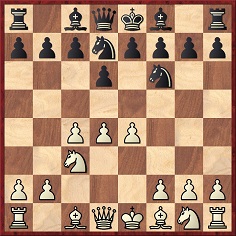
‘Players like Chigorin undoubtedly dread the usual routine of the queen’s pawn opening, because of the difficulty which, as Black, they must experience before they can hope to attain any kind of attack or superiority. By some curious process of reasoning they resort to outlandish manoeuvres, hoping that something beneficial might turn up, or that irregularity may help originality. And so this position arises, where White has freedom and Black confinement. And this at no cost to White of material or weakness on the right, left or centre of the board. Conceding such an advantage, the result is inevitable against correct play. The queen’s pawn opening is certainly very strong for White, as indeed are many other openings. But the philosophy which induces a player with the black pieces to hope to win with moves which it is impossible to conceive are the best available only increases the inherent difficulties that have to be contended against.’
(12084)
First occurrence of the moves:
First occurrence of the term ‘Queen’s Indian Defence’:
First occurrence of an equivalent term in any language:
Robert John McCrary (Columbia, SC, USA) points out the first note to the game between Hanham and Ryan published on pages 209-210 of the July 1886 International Chess Magazine:
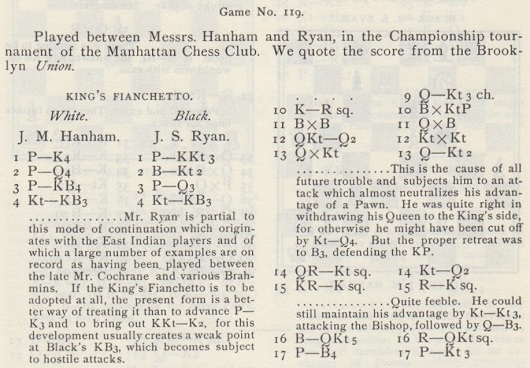
Concerning the conclusion of the game, see page 291 of A Chess Omnibus.
(9006)
Martin Sims notes Réti’s exposé, which includes ‘Vollindisch’ among the terms credited to Kmoch, on page 253 of Die Meister des Schachbretts (Mährisch-Ostrau, 1930). After stating that the term ‘Indisch’ came ‘nach einem Einfall Tartakowers’, Réti wrote:
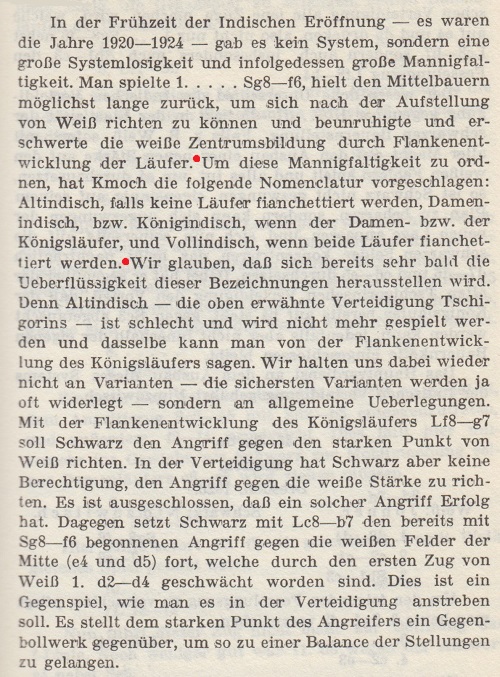
The corresponding passage on pages 137-138 of Masters of the Chess Board (London, 1933) had ‘All Indian’:

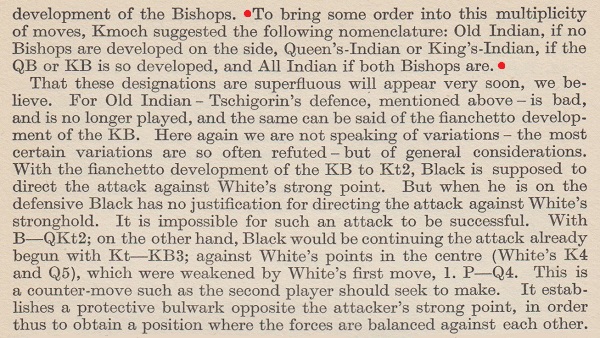
We add that the names for Indian openings were discussed, unwelcomingly, in a letter to the BCM from ‘Episcopus’ on pages 246-247 of the June 1932 issue:
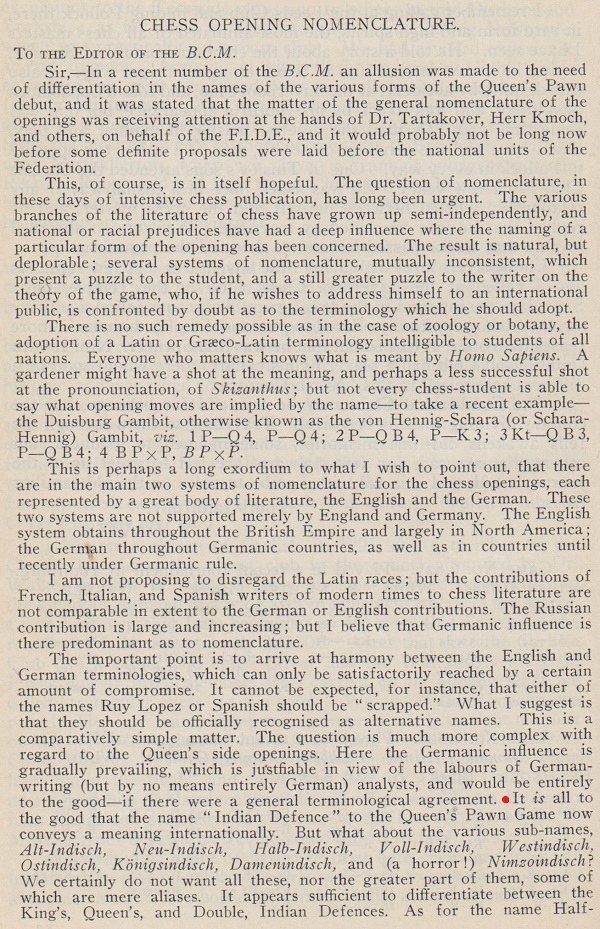
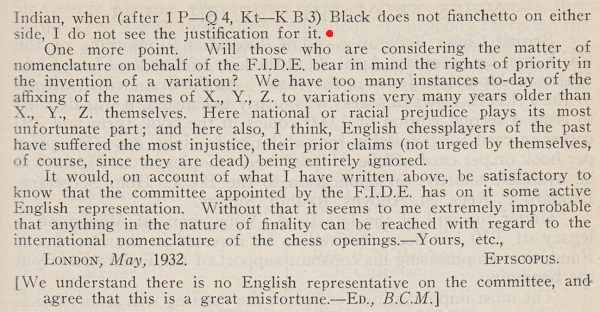
C.N. 3902 discussed FIDE’s attempts to standardize nomenclature, which culminated in the publication of Débuts du jeu d’échecs (Prague, 1934):
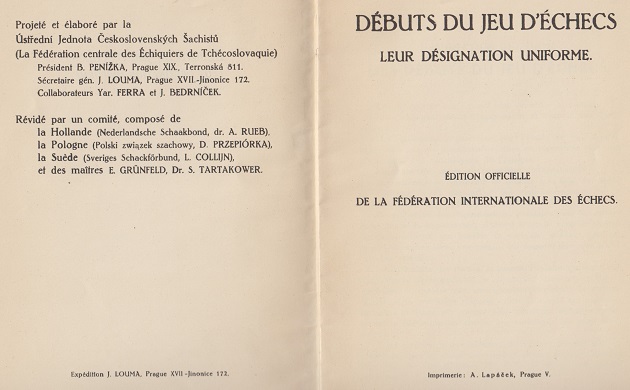
Pages 18-20 set out the fruits of the teamwork on the ‘Partie indienne’:
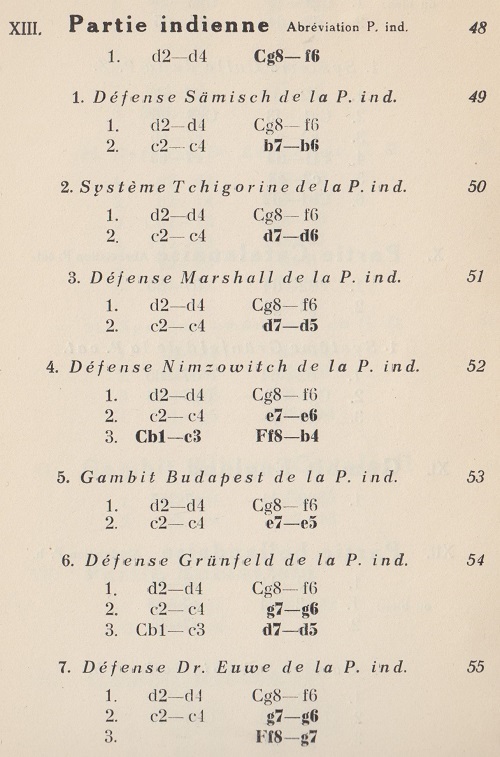
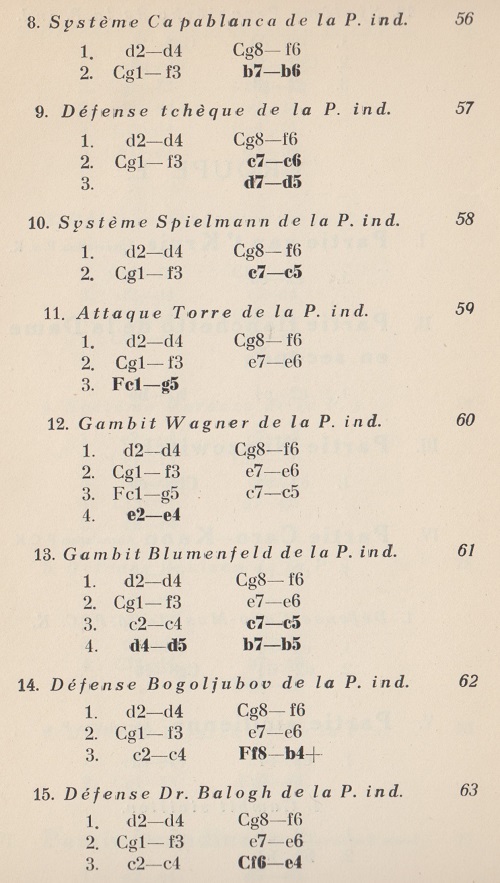

(10058)
Regarding Réti’s above-mentioned statement (see C.N. 10058) on page 253 of Die Meister des Schachbretts (Mährisch-Ostrau, 1930) that Kmoch had proposed a set of terms which included Altindisch for an opening with no fianchetto ...

... in C.N. 10425 Martin Sims drew attention to a footnote by Kmoch on page 33 of Die Kunst der Verteidigung (various editions – the book was first published in 1927):

The term here was not Altindisch but Halbindisch.
A remark by Tartakower on page 37 of the Wiener Schachzeitung, April 1923:

(11015)
To the Chess Notes main page.
To the Archives for other feature articles.
Copyright: Edward Winter. All rights reserved.